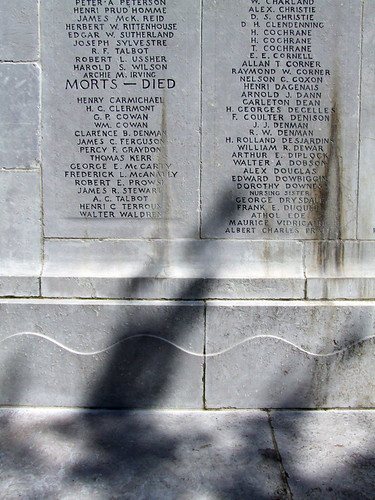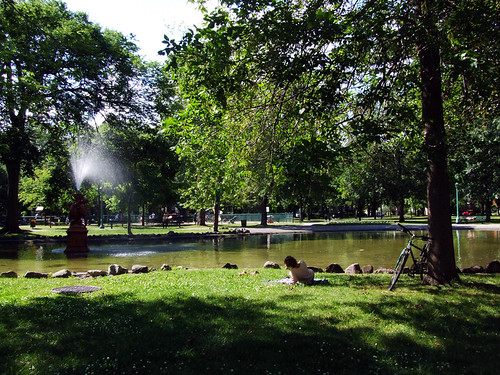On a warm day—or, even better, on a warm night—I like to walk through Outremont. It’s one of Montreal’s most picturesque boroughs, with streets as orderly and genteel as many of its inhabitants. Like Westmount, Outremont was conceived almost from the beginning as an enclave of the well-to-do. Building codes mandated large setbacks, abundant greenery and the use of high-quality building materials in order to keep housing costs high. Architectural features perceived as unsightly and working-class, like outdoor staircases, were banned.
One happy consequence of all this was that Outremont ended up with a collection of gorgeous city parks unrivalled by any other part of Montreal. The park system was conceived when Outremont boomed in the 1910s. In response to this massive spurt of growth, the town council embarked on a campaign to green the burgeoning suburb, investing $5,415 in tree planting and $14,456 in their maintenance, at a time when the average annual salary of a civil servant was just $1,000. Under the guidance of the engineer Émile Lacroix, landscape architect Aristide Beaugrand-Champagne and the horticulturalist Thomas Barnes, eight parks were built between 1920 and 1930.
 Touring these parks is a great way to see Outremont. Since I live on Park Avenue, I usually start my walk from the east, heading down Bernard Street to St. Viateur Park, behind the Cinq Saisons supermarket and the York Apartments. Despite its small size, this is a particularly pleasant park, with some tennis courts, a wide, meandering stream and a white stucco pavilion facing a lagoon. During the day, you will often find kids from the adjacent high school hanging out; at night, when the orangey-yellow light of its interior lights are reflected on the lagoon, the pavilion is sometimes taken over by waltzing middle-aged couples.
Touring these parks is a great way to see Outremont. Since I live on Park Avenue, I usually start my walk from the east, heading down Bernard Street to St. Viateur Park, behind the Cinq Saisons supermarket and the York Apartments. Despite its small size, this is a particularly pleasant park, with some tennis courts, a wide, meandering stream and a white stucco pavilion facing a lagoon. During the day, you will often find kids from the adjacent high school hanging out; at night, when the orangey-yellow light of its interior lights are reflected on the lagoon, the pavilion is sometimes taken over by waltzing middle-aged couples.
If you head down Bloomfield Street, past the pavilion and and on other side of the high school, you’ll arrive at my favourite park in Outremont, which is named, appropriately enough, Outremont Park. I like it mainly because it seems to represent the ideal neighbourhood park, a lush and lively place with meandering paths, a pond and fountain, a playground always filled with children and a memorial to the sons of Outremont that fell in the two world wars. I sometimes go to read the names inscribed on the monument: Henri Prud’homme, Robert Ussher, Thomas Kerr. Most of them are English, a testament to the large anglophone population that resided in Outremont before World War II.
 This best thing about this park is the people-watching. It seems to attract people from across Mile End and Outremont and it is must more bustling than most of the borough’s other parks. Sit down on one of the benches surrounding the pond and take in the scene: Hasidic Jewish kids running around the playground while their mothers chat; couples lying on blankets spread out across the lawn; curious children staring into the murky pond water. Even after dark, when you would expect a park like this — ringed by stately and imposing houses — to be completely dead, there are still neighbours sitting around gossiping and families playing on the grass.
This best thing about this park is the people-watching. It seems to attract people from across Mile End and Outremont and it is must more bustling than most of the borough’s other parks. Sit down on one of the benches surrounding the pond and take in the scene: Hasidic Jewish kids running around the playground while their mothers chat; couples lying on blankets spread out across the lawn; curious children staring into the murky pond water. Even after dark, when you would expect a park like this — ringed by stately and imposing houses — to be completely dead, there are still neighbours sitting around gossiping and families playing on the grass.
Leaving Outremont Park, head down the gentle curve of Elmwood Place, where a path leads to a much quieter green space, FX Garneau Park. Here you will find Outremont’s diminutive town hall: keep an eye out for the exclusive scotch bar on the second floor, where disgraced mayor Stéphane Harbour used to invite a few of his colleagues for glasses of taxpayer-funded $1,000 single malt. For the most part, though, it’s a pretty ordinary park, so it’s best to move on to Beaubien Park, one short block away. This spacious park is much larger and more utilitarian than any of the others, with a playing field, a concrete plaza and a large playground. In the summer, a large jet of water blasts out from a fountain near the corner of Côte Ste. Catherine and McEachran.
Walk up McEachran to Bernard, which at this point is a leafy boulevard lined by attractive apartment buildings, and turn left. Two blocks up the hill is Joyce Park, the first of a pair of parks on Outremont’s western border with Côte des Neiges. There’s a small pavilion through which you can pass into an ample playground, which is especially fun at night. Joyce Park is a pleasant though unremarkable place to spend time, but just west of it is the far more intriguing John Pratt Park, a lushly forested, hillside green space with two ponds linked by a bubbling stream. With no playgrounds or lawns, this is probably the least functional of Outremont parks, but it’s the perfect place for quiet reflection, and a good place to end a leisurely stroll.
Click here to see a map of the walking route described in this article.



14 comments
I already know the first two parks, near PGL, but I’ve just noticed Saturday the name of the park along the 51 bus route: Beaubien… Thanks for the map, good text too.
Wonderful post.
I first happened across some of these parks on a 20-below January night only weeks after moving here, when I decided to walk home from Pharmacie Esperanza to Côte-des-Neiges. Even then I could tell it would become a favorite route-de-flânerie. (See Baudelaire for that usage of a word more commonly used to mean loitering.) Lajoie is a favorite alternative to Van Horne, going by the last two parks of your series; great places to just stop and “set a spell” on a park bench late at night.
On a tangent, I’m curious as to how the Outremont panhandle jutting into Côte-des-Neiges near U. de M. came to be… Snaps from the excellent Navigateur Urbain java mapper ( http://www.navurb.com/nu_inter/index.html ):
Overview: http://www.box.net/shared/static/hofitii2og.jpg
Closeup: http://www.box.net/shared/static/g4qafcsisw.jpg
It encompasses most of avenue Willowdale, in a neighbourhood that’s one of my favorites for late night walks.
Kaï, I’ve wondered that myself. The panhandle is centred on Willowdale Avenue, a gorgeous street I wrote about in the fall, but I don’t actually know why it exists.
https://spacing.ca/montreal/2007/10/16/willowdale-avenue/
Lajoie is a very nice street to walk down. Ducharme, on the other side of Van Horne, is less pleasant but another good alternate route, especially if you’re biking. It will also take you past John F. Kennedy Park, which I didn’t mention in my post but is an interesting little green space occupied mainly by an outdoor pool. There’s a nice 1960s-era pavilion there too.
I love doing that walk, or cycle trip. Though do obey the “no cycling in parks” rule – the para-police in Outremont don’t mess about in applying it. I remember the infamous “men must wear shirts” law a few decades back – a friend, very buff back then and proud of it, was fined for riding his bicycle in shorts and no shirt or t-shirt.
St-Viateur Park is most theatrical!
Could the panhandle have something to do with the large number of Université de Montréal profs living in that area? Hmm.
That’s an interesting theory, but the strange thing about Willowdale is that it’s not a particularly posh street. It’s lined by fairly ordinary four-plexes and duplexes on one side and apartment buildings on the other. In fact it’s pretty much indistinguishable from the adjacent streets in Côte des Neiges.
Another nice thing about Outremont strolls is all the stained glass windows in homes.
One doesn’t need a keen eye to see the loss to our city’s personality from all the people who tore out the stained glass and replaced their windows with modern panes.
There should be an official heritage stained glass-stroll circuit – one where homes light their glass for the stroller’s benefit – and delight.
I went to Outremont High School in the late 60’s / early 70’s. The island in St. Viateur park behind the Cinq Seasons (was a Steinbergs back then) was a favorite place to spend the afternoon when skipping school. Joyce Park was the place everybody spent the last week of May “studying” before exams instaed of going to classes. Was and still is a beautiful park. JFK Park ( used to be St Cyril Park) was where the tough kids hung out, we generally avoided that one. Beaubien Park back in those days was just a flat open field behind the High Schhol,that park was developed in the 1980’s I believe.
In regard to Willowdale Ave. Today it may not be a particularly posh street, but it was back in the 1930’s and 40’s. Though I have no idea why it is part of Outremont.
Thanks for the great post, Christopher. Grew up on St Urbain St (I live overseas now) and often visited Outremont just to see the beautiful parks and homes.
Such beautiful photos and such great memories.I went to Outremont High,lived on Lajois St.I have not been back to that area since 1966.Thank you for this journey down “memory lane”
Natalie
I have been searching for an old friend from Outremont, called Natalie Derwent, for several years. Is there anyway I can get in touch with the Natalie Derwent who left a comment above? If you have her email, can you forward her mine?
Thank you
I love this article. I grew up on Waverly St and Bernard back in the 40’s and 50’s and used to go ice skating Wednesday and Friday nights and all week-end at Outremont Park where the pond goes all the way around. Great music to go skating. I know it used to cost $1.65 for a season pass for the above times and $4.40 for anytime. Is there still a skating rink there? I haven’t been back to Montreal for many years but hope to some day.
I grew up in Outremont and I still live in Montreal-though unfortunately not in Outremont.I still love visiting the old parks-especially Outremont Park.
Just as Halina Szypulin has been looking for Natalie Derwent, I have been wondering about Halina Szypulin. An uncommon name, We dated a few times in the late 60s. Oh, I also lived in Outremont for a while, on Lajoie, if memory serves.